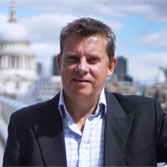After working in South Africa, Gandhi left India just once, for a three-month stay in Bromley-by-Bow...

Gandhi being mobbed by cheering supporters in Canning Town, 1931
Of all the boroughs in all the world, Gandhi chose to stay in Bromley-by-Bow for 12 weeks when he visited for the London Conference in 1931. Long before the area to the north hosted to the 2012 Olympic Games, and before the Kray twins opened their infamous 'Double R Club at 145 Bow Road, the bane of the British Raj would rise early onto his west-facing roof terrace and stroll along the canal.

The outside of Kingsley Hall as it is today. Photo My Bathroom Wall
The round table talks in London were convened to discuss constitutional reforms in what was then British India, but Gandhi missed the first talks as he'd been imprisoned by the Raj authorities, owing to the Civil Disobedience that he fostered. However, in March 1931 Viceroy Irwin met Gandhi and agreed that he could take part in the second Round Table Conference if he halted the civil disobedience, to be held in London from 7 September to 1 December 1931. To ease the way the British freed 19,000 Congress members from prison and returned confiscated property.
Despite his fame and status as the Indian National Congress party leader he chose not to stay in the posh West End hotel offered to him by the British government. Instead - and displaying deft political antenna - he chose to stay among London's poorest people, in Bromley-by-Bow, and took up an invitation from Muriel Lister to stay at Kingsley Hall. He said that was 'doing the real round table work, getting to know the people of England'.
Muriel Lister cheerily explains where Gandhi will stay during his time in London
While the press was dismissive, Pathe patronising, and Churchill downright rude, locals took Gandhi to their hearts and kids soon fell into calling him ' Uncle Gandhi'. In this rough and poor industrial area in the heart of the East End, his slight frame in sandals and wearing only a lion cloth, became a familiar figure, as he took time to mix with locals and took an early morning constitutional along the nearby canal.
Kingsley Hall is on tiny Powis Road in Bromley-by-Bow and was founded in 1915 by Muriel Lester (she was twice nominated for the Nobel Peace Prize) and her sister Doris. These pacifist and feminist sisters converted a small chapel into a community bulwark against grinding poverty with the help of their shipping magnate father Henry and their brother Kingsley's inheritance. They helped the local poor and gave shelter to the suffragettes (the east London H.Q. of her Women's Social and Political Union was nearby on the Bow Road), and helped to feed and water the 1936 Jarrow Marchers.

This Blue Plaque was unveiled in 1954 to commemorate Gandhi's stay at Kingsley Hall. Photo My Bathroom Wall
The stone laying ceremony for the current hall was attended by Sibil Thorndike (who Bernard Shaw wrote Joan especially for) and John Galsworthy (author of the Forsyte Saga) and it was opened in 1928.
Lylie Valentine became a worker in the nursery and in her pamphlet: Two Sisters and the Cockney Kids, tells of Gandhi’s 12-week East End sujorn. "....besides doing his work with the Government, he spent a lot of time with us. He visited the Nursery School and all the children called him Uncle Gandhi. At six o'clock each morning, after his prayers, he took his walk along the canal, talking to workmen on the way.... There was something about him that always lives with the people."

Gandhi posing with local children and Labour Party leader George Landsbury inside Kingsley Hall, 1931
It's nice to think of Gandhi wandering along the local canal. If he strolled five minutes east from Kingsley Hall he'd have come to the mill complex, or if northeast he'd have passed more factories in the area that's now the Queen Elizabeth Olympic Park. The Lea Navigation, as the local canal is known, is a river that's been much altered by the need for waterborne transport during the Industrial Revolution and meets the River Thames at Trinity Buoy Wharf - read about it on My Bathroom Wall.
Sadly the hall had fallen into disrepair by the time its modern day savour appeared on the scene. This was in 1980 when Sir Richard Attenburgh was scouting for authentic locations to use in his epic film, Gandhi, and thanks to his support the hall was renovated and re-opened in 1985.

Kingsley Hall in 2017 preparing for a Bengali wedding, and in 1931 with Gandhi and local pearly luminaries
The hall was later used by the Philadelphia Association, which was formed in 1965 by the Scottish psychiatrist R.D.Laing and colleagues. This controversial group believed in metanoia (self-healing) and though they eschewed most medication, they did occasional use small doses of LSD as therapy. The 2017 film 'Mad to be normal' follows Laing and his patients during their time based at Kingsley Hall.
These days Kingsley Hall is used as a wedding venue, and many community groups meet there. There is also a simple cafe that opens on Tuesdays.
Back in 1931 unrest continued to grip India during the conference, which wasn't helped by the then Labour government fell two weeks before the start of the meetings. The conference achieved little and Gandhi and other Congress leaders were arrested on their return to India.
Alas the tree that Gandhi is seen here planting was destroyed during the Blitz
One more thing....If Gandhi felt pekish for a 'Ruby Murray' - Cockney rhyming slang for a curry - he didn't have far to go. In fact Britain's love affair with Indian cuisine began long before Gandhi's visit, and long before his fist stay in the city as a student in 1888 even.
It's thought that the first time curry appeared on the menu was at the Norris Street Coffee House on London's Haymarket in 1773, which even then offered to “at the shortest notice (send) ready dressed curry and rice, also India pilaws, to any part of the town.” And then the first place owned and run by an Indian was the Hindoostane Coffee House, set up by Sake Dean Mahomed in 1810 on Marylebone's George Street, which according to the original Epicure's Almanack of 1815 - London's first restaurant guide - was decorated with 'Chinese pictures and other Asiatic embellishments, representing views in India, oriental sports, and groups of natives decorated the walls'.
The oldest surviving Indian restaurant is Veeraswamy (99-101 Regent Street, London). It was founded by a retired Indian Army officer called Edward Palmer in 1926, himself the grandson of an English general and an Indian princess. He'd been promoting Indian food since 1896 and was called in as an advisor by the Indian government to the 1924 British Empire Exhibition at Wembley Park, and was a hit with British visitors serving 500 curries a day. The Regent Street restaurant was and is high end, and in 1936 published recipe's in its Indian Cookery for Use in All Countries. It now has been given a Michelin Star in its 2017 guide.

It is even possible that the tradition of drinking lager with a curry is related to Prince Axel of Denmark's visit to the Veeraswamy-connected Indian restaurant at the British Empire Exhibition on 2 May 1924. He enjoyed his meal enough to later visited the Regent Street restaurant, when he was supposed to have brought a barrel of his native Carlsberg with him. He sent a barrel of Carlsberg to the restaurant for years thereafter, which proved popular enough for the restaurant to start importing Carlsberg itself, and when its waiters moved on to other Indian restaurants, they started serving Carlsberg as well.
 |
Kingsley Hall is five minutes walk from Bromley-by-Bow tube station on the District and Hammersmith & City Lines. Also see the Gandhi Foundation, and the House Mill |





